MEMENTO MORI (2004)
Memento Mori is a jewellery series that revisits an ancient tradition and depicts death – common old-age death. The jewellery comments on contemporary old-age death but also depicts death in a universal sense.
Memento Mori is a jewellery series that revisits an ancient tradition and depicts death – common old-age death. The jewellery comments on contemporary old-age death but also depicts death in a universal sense.
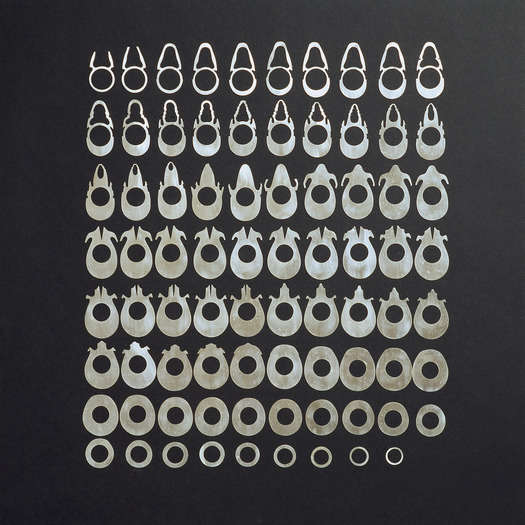
Silver
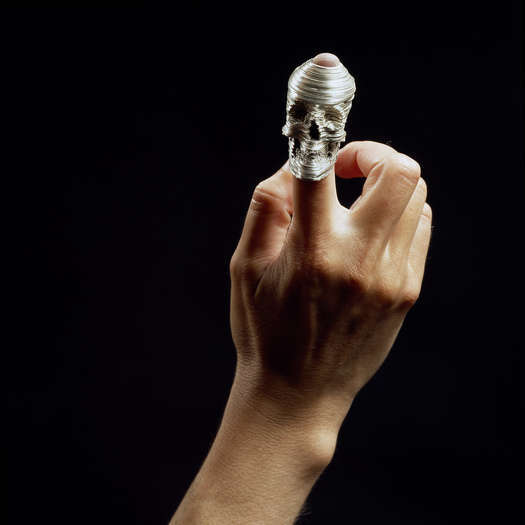
Silver
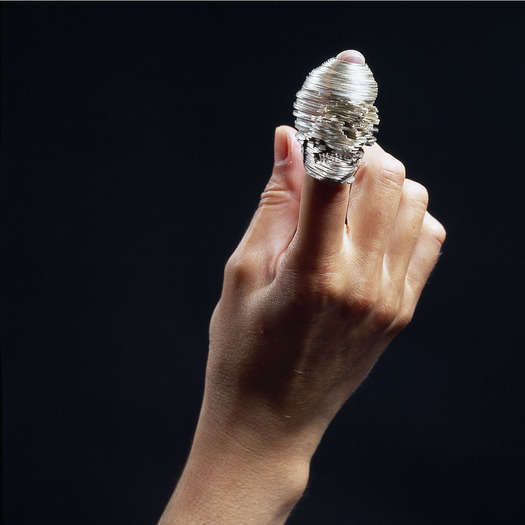
Silver
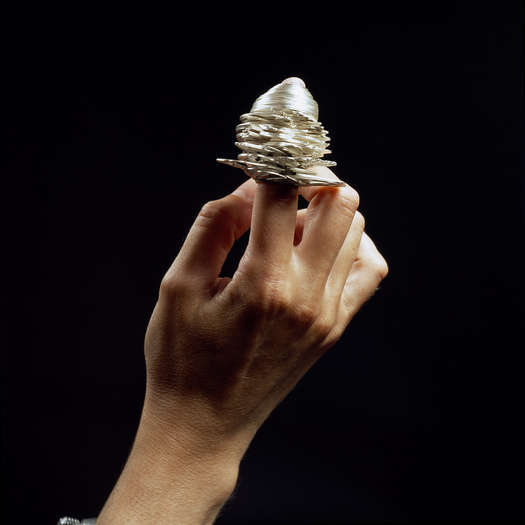
Silver
The "Skull" ring is made from 79 layers of thin silver sheet, corresponding to the average life expectancy for a Danish woman. Placed on top of each other in the right order, the layers form a skull that can be worn on the finger. The individual layers can rotate independently around the finger, rendering the skull motif more or less apparent.
The blurred skull suggests that common old-age death is virtually invisible in our society. On a daily basis, we are confronted with images of death in the media, but we rarely see images of common old-age death. Besides, nowadays most old people die in hospitals and nursing homes, and thus common old-age death has ceased to be a part of our everyday life.
Unlike other classic symbols of the fleeting nature of life, such as hourglasses, extinguished candles and soap bubbles, the skull is not merely an abstract image of death but also a concrete image of death and the bodily decay that accompanies it. Few of us are familiar with that aspect of death, and many fear it. The blurred skull can also be seen as a representation of the fear of dying.
The layering of the skull and the layers' resemblance to tissue samples for microscopy as well as scanning and X-ray images lend "Skull" a clinical touch, suggesting that many modern people have a rational and abstract relationship with death.
However, the layering also indicates the possibility of reintroducing the traditional ritualistic approach to death, as the layering makes it possible to share and distribute the ring – for example to friends and relatives as a sort of bonding amulets, or to randomly selected people as a reminder that regardless of gender, race and education, we are all subject to the common human condition of being mortal.
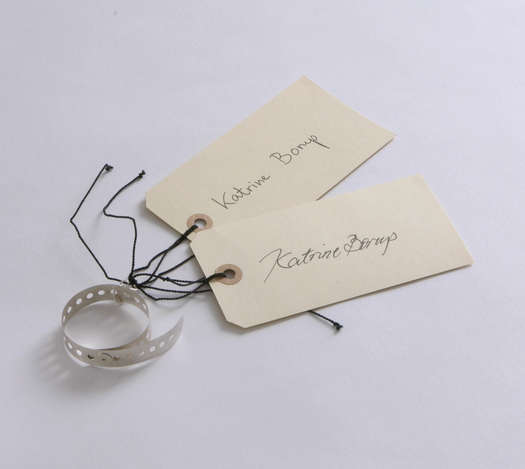
Toe tags, silver and silk cord
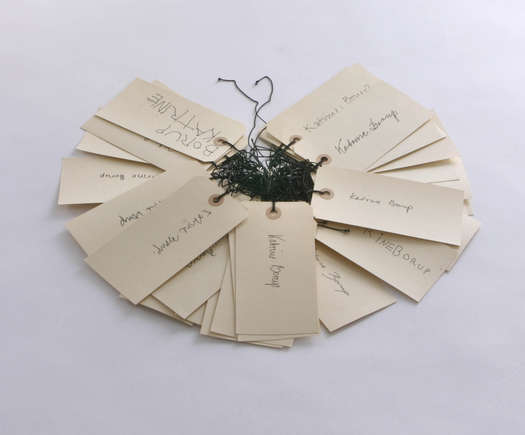
Toe tags, silver and silk cord
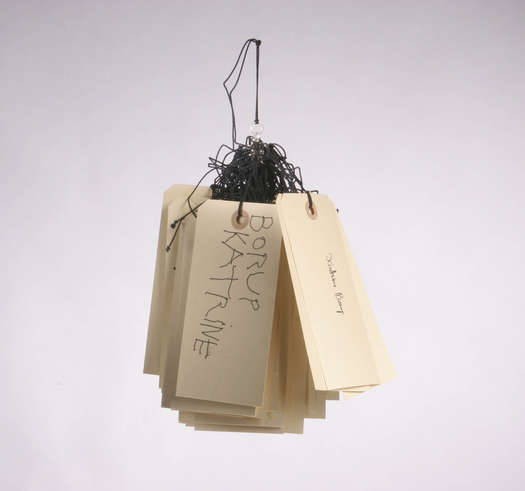
Toe tags, silver and silk cord
"Ritualised Hospital Routine" is made of so-called manila tags – tags like those used in many hospitals and nursing homes when someone dies. The nursing staff notes the person's name, ID number and time of death on the tag, which is placed around the deceased person's right big toe.
"Ritualised Hospital Routine" is a transformed or revised toe tag – a fictitious piece of death jewellery for myself. In their own handwriting, each of my relatives, friends and acquaintances have written my name on individual manila tags, which are then bundled.
Unlike the hospitals' practical and impersonal labelling, "Ritualised Hospital Routine" is jewellery that draws an image of the dead as a person, a mother, daughter, sister, lover, friend, colleague, and so forth. It involves the people who throughout my life have shaped me into who I am and given my life substance, inviting them to also play a role at the end of my life. In that sense, "Ritualised Hospital Routine" is a piece of life jewellery.
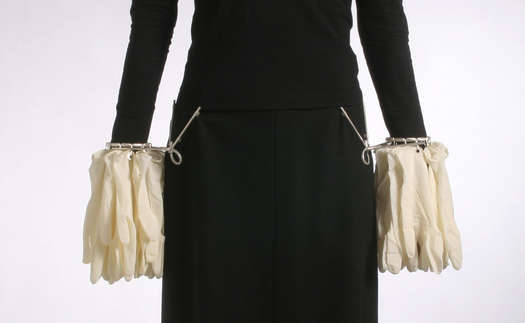
Disposable gloves, plastic and silver
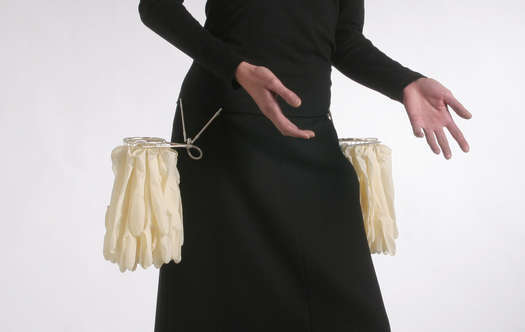
Disposable gloves, plastic and silver

Disposable gloves, plastic and silver
"Hourglass" is a set of unusual bracelets. They are made of silver and disposable gloves like the ones used by the staff in hospitals and nursing homes. The bracelets are attached to the wearer's hips, pinning the wearer's arms to her side, when the bracelets are placed around the wrists.
"Hourglass" is an image of the helplessness that a dying person or a relative may experience within the care system once the "rubber gloves" take over. The bracelets can also be seen as a tempting hideaway that one may seek out in order to hide behind the "rubber gloves".
Like "Skull", "Hourglass" plays with an ancient memento mori or vanitas symbol. The arm rings of heavy silver are filed into the shape of tiny hourglasses placed in extension of each other and bent into a ring. The rack that fastens the arm rings to the wearer's hips is also shaped like a stylised hourglass. The waist of the hourglass has been replaced by a plastic hose. Inside the hose is the silver dust that was filed off the arm rings. The hose made it possible to break the hourglass, which prevents the silver dust from passing through. Symbolically, this signifies immortality, and maybe one of the consequences of hospitalised death is precisely that it facilitates the denial of death.